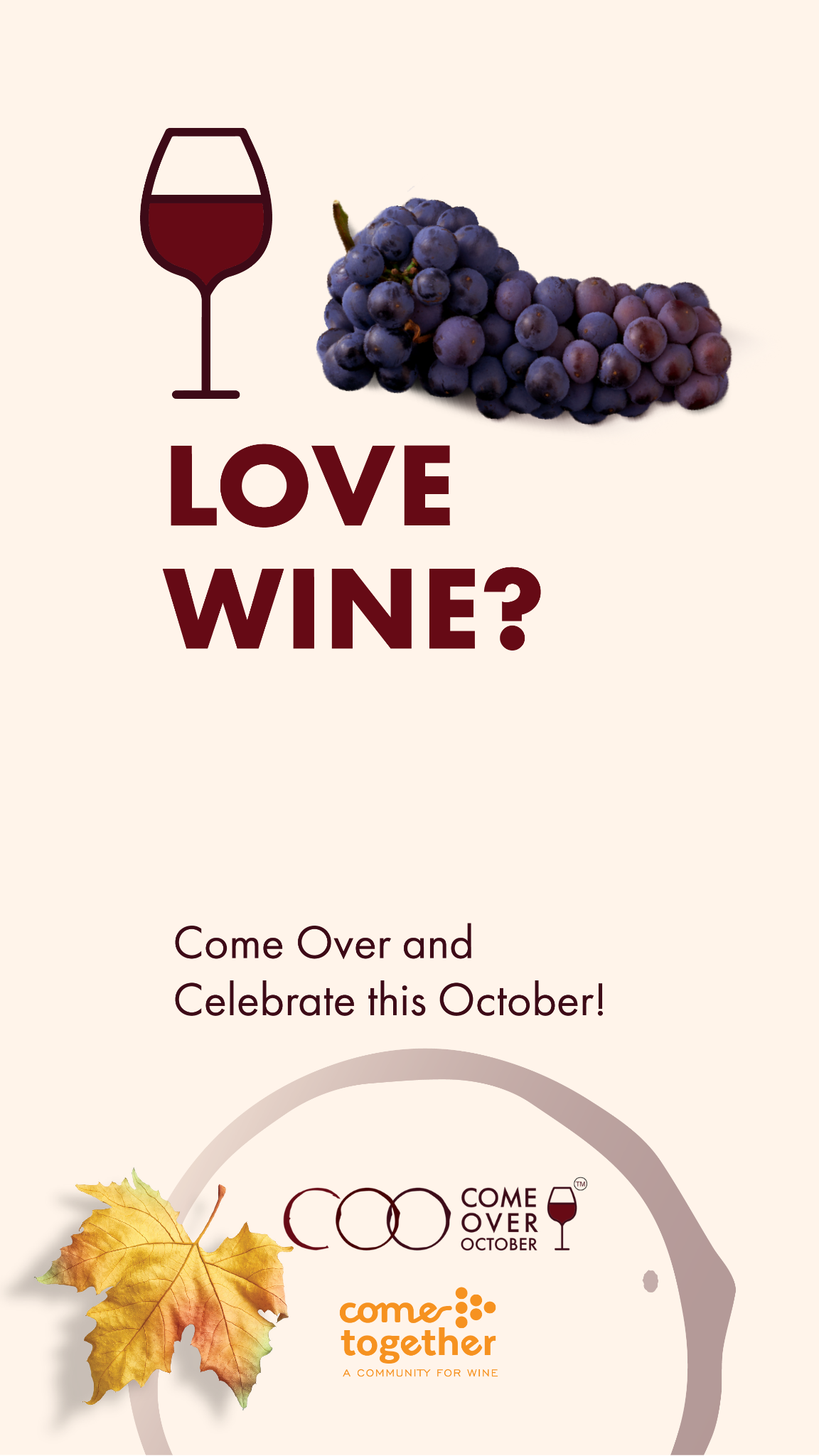
Wine’s Rally Cry
The Marketing Behind Come Over October
Hopefully, by now, you’ve seen some wineries participate in Come Over October, a new program launched to benefit the wine industry. Our industry is facing a critical shift where the cultural narrative around wine is being scrutinized. At the same time, loneliness and isolation are now at epidemic levels, and the simple act of sharing wine, which has always been a catalyst for connection, seems to be losing its place. The goal of Come Over October, launched by wine journalist Karen MacNeil and PR veterans Gino Colangelo and Kimberly Noelle Charles, is to counter these trends. The idea is simple: encourage friends, family, and colleagues to “come over” in October to share a bottle and reconnect. It’s not about fancy wine pairings or breaking the bank—just using wine as a focus to celebrate being together in an increasingly disconnected world. The wine industry, as always, adapts to challenges, and this campaign is a reminder that wine, at its core, is about community and connection.
This blog explores some of the thought behind the program and why you might want to support it (if you’re not already.)
What is a Category Campaign?
What type of campaign grows the entire category? Well the first type isn’t advertising a brand at all. The concept of advertising a category and not a specific brand is nothing new. There are several examples of advertising and marketing campaigns that focus on elevating the category as a whole, benefiting all players within the industry. One of the most famous category campaigns, “Got Milk?” didn’t promote any particular brand of milk but encouraged consumers to drink more milk overall. The campaign used humorous and relatable scenarios to remind people of milk’s importance in everyday life. “Cotton: The Fabric of Our Lives” is a long-running campaign highlighting the benefits of cotton over synthetic materials. And who could forget the “What Happens Here, Stays Here” ads that promoted the city of Las Vegas as a whole, rather than a specific resort or casino. These campaigns all share a focus on growing an entire industry or product category, with the benefits spilling over to all brands within the sector.
But another way to do this is have a single category leader out there banging the drum for their brand, but the awareness helps everyone in the group. The most obvious one here is White Claw. White Claw didn’t invent hard seltzer, but it became the brand that catapulted the category into the mainstream. Its simple branding and appeal to health-conscious drinkers helped the hard seltzer market explode and benefitted brands like Truly (Boston Beer Co.), Bon & Viv (AB InBev), and others who quickly jumped into the hard seltzer craze.
Another example is Red Bull. They essentially created the modern energy drink category in the 1980s and 1990s through aggressive marketing, including extreme sports sponsorships and its iconic “Red Bull gives you wings” campaign. Red Bull introduced energy drinks to a mass audience. While Red Bull remains the category leader, the overall awareness of energy drinks grew significantly, bringing in competitors like Monster, Rockstar, and others, and expanding the entire market.
And what about Apple? Apple’s iPhone wasn’t the first smartphone, but it completely revolutionized the category. Through its product innovation and highly effective advertising (remember “There’s an app for that”), Apple grew the smartphone market, which ultimately benefitted players like Samsung, Google (Pixel), and smaller manufacturers. The smartphone category exploded as a result, with more users switching from feature phones to smartphones globally.
In all these cases, the category leader’s advertising or marketing efforts didn’t just grow their own market share; they expanded the entire category, which brought new consumers to the space and allowed competitors to thrive as well.
Wine Used to Have These Category Leaders…
Back in the 70’s and 80’s – wine was in your face on TV and fun! You could hardly watch your episode of M*A*S*H without seeing a Riunite commercial with their corny jingle, “Riunite on Ice, That’s Nice!”. This campaign not only sold a ridiculous amount of wine, but also paved the way for wine to be associated with being social and non-pretentious for the category. At the same time, the Paul Masson glitzy commercials with industry superstar Orson Welles did wonders for California and domestic wines at a time when most serious drinkers only drank imports. And their tagline, “We will sell no wine before it’s time,” was so pervasive it became a much-parodied cultural trope of the latter half of the 20th century. In a sense, these two brands’ commercials acted as category campaigns, positioning wine in a way it had not been perceived until that point and giving people permission to try it. These and other campaigns in the 70’s and 80’s created a place for wine in the lexicon of the time and helped cement “wine=domestic=social=universal” in Baby Boomer’s minds, paving the way for the exponential growth we have become accustomed to, until recently, that is.
Why We Need A Category Campaign Now
Things are different now. Somewhere, we lost the glitter and the smiling people at dinner parties and on jet skis, and wine went sour. Everywhere you look there are articles about how wine has become far too serious, too complicated, and too confusing for consumers. The resulting category is stagnating, at best, and in decline, at worst. We can all agree the wine category, for the first time in a long time, needs help attracting new consumers and reminding the general drinking population wine has been at the center of fun and social gatherings forever. It is the drink that is as comfortable at an informal gathering with a cheese board as it is at a formal, sit down, holiday dinner with the family.
These societal opinions on wine are made more daunting when layered with the current media landscape. In our fragmented world, with its endless advertising platform and channel options, it is hard for today’s individual wineries to make a dent in consumer attitudes and behaviors, especially with the small marketing budgets most wineries have to work with (very few of us have the budgets of Kim Crawford). It’s not realistic in 2024 for enough brands to pull together to agree on one message in agreed channels for a coordinate effort.
Or is it?
This is why we feel Come Over October is an idea whose time has come. It is a campaign that supports the wine category by reminding people socializing in IRL is good for us humans and that wine is a natural accompaniment to these occasions, especially the more informal ones. Every winery who “donates” precious space and/or dollars to promoting Come Over October is contributing to the larger goal of trying to re-trigger category growth.

Aligning With How Consumers See Wine
A recent Wine Market Council and Ethnifacts Research panel asked consumers how they consumed and enjoyed wine. The study concluded consumer most often view wine as a compliment for casual and fun get togethers. The participants relayed that in real life, wine is being served at everything from trivia nights to murder mystery parties to candle making. But this is not how wine is typically portrayed by wineries. We tend to focus on ceremonial tastings/smelling/swirling of glasses, or on romantic or formal couples. Noticeably, all the suggestions made by respondents in this research were social, not solitary individuals or couples. (Side Note: Take a look at your Instagram. How many images are of individuals or couples drinking your wine? And, do they look like they are having fun?)
Which made us think of other alcohol categories who associate themselves with social occasions and having fun – Beer and Hard Seltzers. Beer is notoriously all over the Super Bowl (the most social TV event of the year). For the last 30 years, Budweiser has been the beer category’s spokesperson and it is safe to say that every beer commercial reinforced the social aspects associated with drinking beer. Even White Claw is all about connecting, being social, relaxed and with friends.
Now it is time for wine to do the same. We need to remind the drinking population, particularly the next generation of drinkers, wine is a social, convivial drink able to be enjoyed across a variety of occasions. We have had some clients decline to participate in the initiative because they didn’t see what was in it for them. And we understand that in a time when consumers are scarce, you are tempted to focus on your individual sales needs. But a category campaign like this is for everyone and will benefit everyone. And, we have to reach critical mass to hope to change consumer perception.
For more details and how you can take part in the campaign please visit the website.


